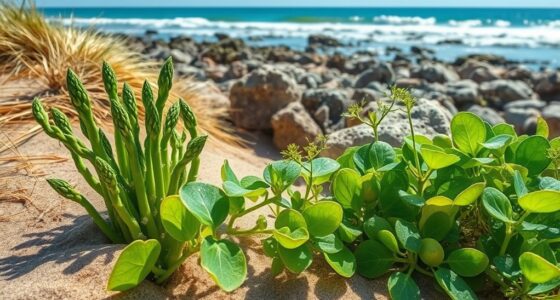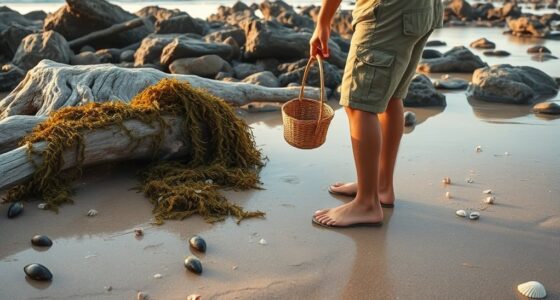To forage for mussels, clams, and oysters, focus on the best seasons—fall to spring for mussels and oysters—while avoiding red tide periods. Use sturdy gloves, shell scrapers, and proper tools, and check for live shells by tapping or closing shells. Always pick clean, pollution-free sites, and rinse your catch thoroughly. Follow sustainable practices by respecting local regulations and environmental conditions. Keep discovering tips to harvest safely and responsibly by exploring more details.
Key Takeaways
- Collect mussels from November to May in clean, pollution-free rocky areas, avoiding red tide seasons from May to October.
- Find clams on sandy or muddy beaches at low tide by spotting ripples or small holes and ensuring gentle currents.
- Harvest oysters near estuaries, rocky outcroppings, or pilings during low tide, away from sewage outlets and runoff zones.
- Use sturdy gloves, shell scrapers, or metal brushes, and handle shellfish gently to prevent damage.
- Verify shellfish are alive by checking shells close tightly or closing when tapped, and rinse thoroughly before cooking.
Recognizing the Best Harvesting Seasons and Sites

To successfully harvest mussels, clams, and oysters, you need to recognize their best seasons and sites. Make sure you go during the ideal times: mussels from November through May, avoiding closures from May 1st to October 31st due to red tide risks. For oysters, look in shallow, brackish waters near estuaries, rocky outcroppings, or pilings during low tide when these areas are exposed. Clams thrive in sandy or muddy beaches with gentle currents, often visible at low tide through ripples or small holes. Always choose sites away from pollution sources like sewage outlets or runoff areas to guarantee safety and sustainability. Natural barriers, like submerged bars or creek mouths, also support healthy shellfish populations, so make sure to identify these prime locations. Incorporating knowledge of best harvesting sites can greatly improve your foraging success. Additionally, understanding the harvesting seasons helps ensure you collect shellfish when they are most abundant and safe to harvest. Recognizing environmental conditions such as water temperature and salinity further enhances the quality and safety of your harvest. Being aware of vetted sources of information can also help you stay updated on current shellfish advisories and regulations. Monitoring local water quality reports is essential to avoid harvesting in contaminated areas that could pose health risks.
Using the Right Tools and Techniques Safely

Using the right tools and techniques is essential for safe and effective shellfish harvesting. Always wear sturdy gloves and use tools like a shell scraper or metal brush to safely remove barnacles and debris from mussels and clams. When harvesting, employ hand or hook-and-line methods instead of pry bars or screwdrivers to protect beds and follow regulations. For oysters, pick them carefully by hand during low tide from rocky outcroppings or submerged structures, ensuring they’re alive before collection. Wear hip boots with secure zip-ties around the ankles to guard against sharp shells and muddy terrain. Handle shellfish gently to prevent breakage, and use measurement gauges to meet legal size requirements. Proper handling and shellfish safety practices help ensure sustainable harvesting and reduce health risks. Maintaining knowledge of harvesting techniques ensures responsible collection and preservation of shellfish populations. Additionally, staying informed about local regulations and guidelines can help prevent illegal harvesting and protect marine ecosystems. Developing skills in food preservation methods further supports a self-sufficient approach to shellfish consumption and storage. It’s also important to stay aware of environmental conditions such as water quality and tides to optimize harvesting efforts and ensure safety.
Identifying Live Shellfish and Avoiding Contaminated Areas

Ensuring shellfish are alive before harvesting is crucial for safety and quality. Check that they are tightly closed or close when tapped; discard any that remain open. Avoid collecting shellfish from areas near sewage outfalls, towns, or visible pollution sources, as these are likely contaminated. Be aware of red tide events, which can produce toxins making shellfish unsafe to eat, even if they appear healthy. Look for natural habitats like clean sandy or rocky bottoms, creek mouths, or submerged bars, which indicate healthier, less polluted environments. Use local resources, online advisories, or consult experienced fishermen to find safe, pollution-free sites. Rinsing shellfish thoroughly in clean water before cooking helps remove mud, debris, and potential contaminants, ensuring safer consumption. Regular monitoring for growing shellfish quality can also help identify safe harvesting areas. Additionally, understanding water quality standards in your region can guide safer foraging practices. Being familiar with shellfish testing methods can further enhance safety by detecting toxins or pollutants before harvest.
Proper Cleaning, Purging, and Cooking Methods

Thorough cleaning is essential before cooking shellfish; rinse them with a metal brush and cold water to remove sand, debris, and barnacles. Proper cleaning guarantees you eliminate grit and contaminants, making your shellfish safe and enjoyable. To purge clams and softshells, soak them in salted seawater or fresh water for several hours, which helps rid them of grit and toxins. Discard any shellfish that don’t open during cooking, as they were likely dead beforehand and may pose health risks. When cooking, steam mussels for about 4 minutes until the shells open, confirming they’re alive and properly cooked. After cleaning, remove any dark tissues or guts, and serve with melted butter or seasonings for ideal flavor. Proper cleaning and purging are key to a safe, delicious seafood experience.
Practicing Sustainable Gathering and Environmental Awareness

Practicing sustainable gathering and environmental awareness is essential to preserving healthy shellfish populations and marine ecosystems. To do this, always harvest from designated, pollution-free areas with minimal human activity, avoiding sites near sewage outlets or runoff sources. Follow local seasonal regulations, such as restrictions during red tide closures or breeding seasons, to help protect shellfish stocks. Use proper tools like rakes or shovels, and handle shellfish gently to prevent habitat disturbance and promote sustainability. Rinse and purge shellfish thoroughly before consumption to reduce bacteria and toxins, supporting ecosystem health. Discard dead or damaged shellfish and only collect from known clean, abundant beds. Additionally, understanding marine conservation can help inform responsible harvesting practices and ensure long-term resource availability. Recognizing the importance of shelf life and storage conditions can also prevent the consumption of spoiled shellfish and maintain safety. Monitoring performance metrics related to shellfish populations can guide sustainable practices and help prevent overharvesting. Incorporating vibrational energy and its impact on marine environments can further enhance responsible gathering. Regularly assessing environmental indicators ensures that harvesting practices are aligned with ecosystem health and sustainability. By practicing sustainable gathering and maintaining environmental awareness, you contribute to the long-term health of shellfish populations and marine environments.
Frequently Asked Questions
How to Forage for Mussels?
To forage for mussels, you should first find rocky coastlines or tide pools where they thrive. Look during their open season from November to May, avoiding red tide warnings. Use gloves or tools like pliers to carefully pry them off submerged rocks at low tide. Rinse them thoroughly with a metal brush to remove debris, and discard any that don’t open after cooking, as they might be unsafe to eat.
How Do You Harvest Clams and Oysters?
To harvest clams and oysters, you dig in sandy or muddy beaches at low tide, looking for ripples, holes, or shell fragments that suggest activity. Use tools like shovels or rakes carefully to avoid habitat damage. Check that shells are closed or close when tapped to guarantee they’re alive. Follow local regulations for size and quantity limits, and always harvest sustainably and legally.
How to Forage for Clams?
To forage for clams, start by exploring sandy or muddy beaches during low tide. Look for signs like small holes or ripples that indicate clam activity. Gently dig in the soft sediment with a shovel or rake, being careful not to disturb the habitat too much. Measure the clams to make certain they’re the legal size, rinse them thoroughly, and avoid areas near pollution sources for safety.
Can I Eat Mussels I Find at the Beach?
You can eat mussels you find at the beach if they’re from a clean, uncontaminated area. First, make sure they’re alive—tight shells when touched and intact. Avoid collecting during red tide or harmful algal bloom warnings. Rinse them thoroughly with a metal brush to remove debris. Only eat mussels that open after steaming; discard any that remain closed, as they may be unsafe.
What Months Are You Not Supposed to Eat Mussels?
When it comes to eating mussels, timing is everything—you don’t want to bite off more than you can chew. You should avoid consuming them from May 1st to October 31st, as they’re closed during these months to protect against red tide toxins. These months align with warmer weather and harmful algae blooms, making it unsafe to harvest or eat mussels. Always check local rules before you head out.
Conclusion
Now that you know how to find and harvest shellfish responsibly, picture yourself walking along a rocky shoreline at low tide, the sun warming your back as you spot glistening mussels and clams nestled in crevices. With your tools in hand, you gently pry them free, mindful of the vibrant tide pools teeming with life. By respecting these waters, you help keep this thriving ecosystem alive for future foragers and marine creatures alike.










